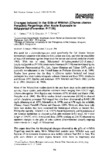Changes induced in the gills of milkfish (Chanos chanos Forsskål) fingerlings after acute exposure to nifurpirinol (Furanace; P-7138)

View/Open
Request this document
Date
1995Page views
284Metadata
Show full item recordCited times in Scopus
Share
Abstract
The need for a chemotherapeutant used specifically for fish disease became increasingly apparent with intensive fish culture practices, and with the possibility of bacterial resistance against drugs used for human and animal medicine (Austin 1985). With this in mind, Nifurpirinol (trade name Furanace; P-7138) was developed by the Dainippon Pharmaceutical Co., Ltd., Japan, and is currently manufactured in the United States as Prefuran. Studies have proven that the drug is effective against bacterial and fungal pathogens in a wide variety of aquatic animals. Most of the Nifurpirinol studies done in the past have dealt on its antimicrobial activity, tissue uptake, and effective treatment levels ranging from 0.5-2.5 mg/L. The 96-hr median lethal concentration (LC50) to channel catfish (Ictalurus punctatus Rafinesque) has also been determined at 0.945-1.90 mg/L, and at 1.70 mg/L for milkfish, Chanos chanos Forsskaal. However, there have only been two studies that have examined the histological effects on treated fish. Histopathologically, Mitchell et al. (1978) found hypertrophy and hyperplasia of the lamellar epithelium in channel catfish gills exposed to 0.5 mg/L for 4 d or longer at 24 plus or minus 2 degree C, while Amend and Ross (1970) working at 21 plus or minus 1 degree C observed no apparent changes in the gills of coho salmon (Oncorhynchus kisutch) exposed intermittently to 1 mg/L of Nifurpirinol. This paper describes the histological changes observed in the gills of milkfish fingerlings used in static, 96-hr Nifurpirinol toxicity tests. Milkfish was used because of its economic importance as a widely cultured food fish in Asia. The gills were chosen as target organs.
Suggested Citation
Tamse, C. T., Gacutan, R. Q., & Tamse, A. F. (1995). Changes induced in the gills of milkfish (Chanos chanos Forsskål) fingerlings after acute exposure to nifurpirinol (Furanace; P-7138). Bulletin of Environmental Contamination and Toxicology , 54(4), 591-596. https://doi.org/10.1007/BF00192604
Subject
Collections
- AQD Journal Articles [1246]

